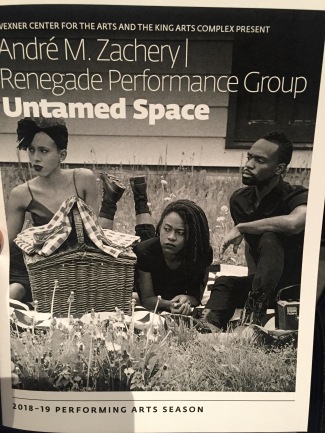 The performance of Untamed Space by Renegade Performance Group was a melting pot of technology, music, movement, and wonder. The melodies and rhythms flowed from the music and was transported into the projections displayed on the scrim and into the bodies of the dancers. Along with responding physically to the music, the dancers created their own sounds becoming instruments themselves. Fusing the technological effects with specific songs related to spirituality and the Black culture, brought the audience into the world of Afrofuturism. The choreography of the show was based upon a series of movements that were used throughout. Pairing specific phrases with music that was complimentary enhanced the reception of the movement, while phrases that were linked to contradictory music allowed for mental contemplation and an acceptance over time. With the bulk of the movement being floor-work and using the technique of physical propulsion, the dancers filled the space and music with electric energy that resonated well after the show is over.
The performance of Untamed Space by Renegade Performance Group was a melting pot of technology, music, movement, and wonder. The melodies and rhythms flowed from the music and was transported into the projections displayed on the scrim and into the bodies of the dancers. Along with responding physically to the music, the dancers created their own sounds becoming instruments themselves. Fusing the technological effects with specific songs related to spirituality and the Black culture, brought the audience into the world of Afrofuturism. The choreography of the show was based upon a series of movements that were used throughout. Pairing specific phrases with music that was complimentary enhanced the reception of the movement, while phrases that were linked to contradictory music allowed for mental contemplation and an acceptance over time. With the bulk of the movement being floor-work and using the technique of physical propulsion, the dancers filled the space and music with electric energy that resonated well after the show is over.
Tag: technique
Analyzing Movement Excerpt
In my History, Theory, and Literature of Analyzing Movement Class we were tasked with creating our own definition of choreographic analysis. Here is an excerpt from the paper I wrote.
When I began thinking about the definition of choreographic analysis, I had to first reminisce on my own artistic life and experiences. I was immediately transported back to my childhood, creating liturgical dances with my mother in our living room. There was such expression, narrative, and meaning behind the movement that I didn’t notice before. Once that initial sense of warmth and comfort left me, I began to think more deeply about the word’s choreographic analysis and its relationship to the world and the articles I had read. My provisional definition of choreographic analysis is the process of examining the lineage and meaning behind specific movement choices, to determine points of origin that corelate to a maker’s choreographic voice.
In my opinion, the most crucial portion of a choreographer’s lineage is the technique they work within. According to Marcel Mauss, a French sociologist, technique is “an action which is effective and traditional” (2006, 82). The aspect of tradition is apparent in all codified techniques, pulling inspiration from religion, geography, and culture. This allows for the practice to stay authentic. Now technique is a vital part of a choreographer’s history that is depicted as their language. It speaks to specific choreographic choices that deal with weight shifts, use of space, or even overall themes of the work being created. “Technique, like language, reaches out to meet us, to envelop us, to structure our lives and relationships, and indeed to make life possible, from the moment we are born” (Spatz 2015, 49). Choreography is a physical statement that holds the passions and the voice of the creator within it. The technique allows the movement to speak to the viewers with a vocabulary that is able to be understood, or not.
With the experiences of the choreographer on display, the formation of the habitus is able to be discovered. “A habitus, understood as a system of lasting, transposable dispositions which, integrating past experiences, functions at every moment as a matrix of perceptions, appreciations, and actions and makes possible the achievement of infinitely diversified tasks,” (Bourdieu 1977, 83). A maker pulls inspiration from every aspect of their life and incorporates that into the work they create. This means that depending upon certain training, interactions with other artists, or teaching techniques, there will be a variance in the experiences of those in the same class. Class is dependent upon the shared environment of a group of individuals. This doesn’t necessarily mean these events occurred for each person in the same chronological order; however, they are shared experiences. These qualities bring a diversity of movement, points of view, and aesthetics that make for a unique viewing experience. Having this background information allows for a holistic approach to the choreographer and the corresponding choices they make when creating choreography and analyzing it.